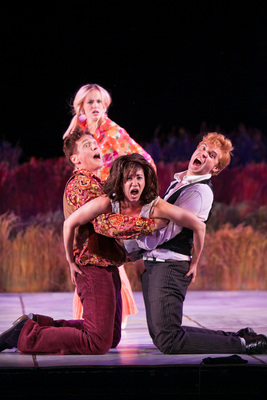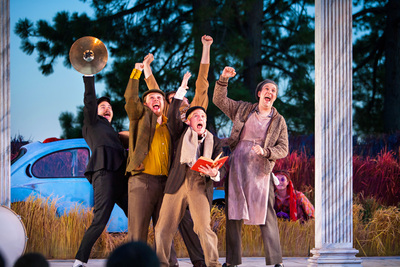Mourning Shakespeare Santa Cruz
August 28, 2013 § 5 Comments
Woe, destruction, ruin, and decay;
The worst is death, and death will have his day.
Richard II, (III.ii)
Earlier this week, the University of California at Santa Cruz announced (through its Dean of the Arts David Yager) that it was pulling the plug on 32 year old, Shakespeare Santa Cruz, their professional theater company in residence. The current season will be its last. Although the finality and timing of the decision was apparently something of a surprise, SSC’s future has been cloudy for some time. The company has struggled since the economic collapse of 2008 decimated higher education funding in California, threatening everything beyond basic instruction.
I am not close enough to the situation to assess the necessity or justness of the decision, but I am certainly among those in mourning not only for death of the company but for the bigger idea it represented.
To me, that idea will always be defined by the late Daniel Seltzer’s 1975 report for the National Endowment for the Humanities about the relationship of professional theaters to American universities, The Ideal Theater-in-the-University. At the time it was written, Seltzer was the head of Princeton’s theater program, and a notable Shakespearean scholar in its English department. He had also just been nominated for a Tony Award for his performance in Jules Feiffer’s Knock, Knock. In other words, he was both a credentialed scholar and a successful actor in the competitive commercial theater. (Sometime those that can, also teach…)
I was lucky enough to meet Seltzer just as I was finishing my undergraduate work. I was a kid just off the farm in Idaho, and my public education (including exposure to Seltzer) was dramatically changing my life prospects. It was his compelling vision of the interaction of university life and theater that interested me then, and still inspires me all these years later. Seltzer participated not only in the commercial theater, but also in the growing regional theater movement – especially at the McCarter Theater – but he was convinced that the Theater-in-the-University (his term) was a special, and vitally important kind of theater, perhaps the most important of all.
In his report, his central argument was that a university theater does not exist just for entertainment, nor even for the specific education of aspiring theater artists. The theater, he believed, should be the campus gathering-place, where a living community converges to consider the important questions of the time. Advocating for his vision, he wrote, “We can take seriously the association of the arts – perhaps especially the performing arts – with important public questions, with the responsibilities of men in public trust, with matters relative to the nation’s well-being. A university is profoundly involved in both the past and the present, and a university’s theater can reveal how dynamically and excitingly the two are connected.”
Perhaps it all seems quaint and idealistic now, as most of our society has long since abandoned the idea that the performing arts are a living library, as indispensable to a complete education as the material library at the center of campus. The proposition that live theater is worth subsidizing for its civilizing value has been under steady attack for decades, not just in the university, but in society-at-large. In fact, it hardly seems fair to damn UC-Santa Cruz for giving up after 32 years on an idea that few other public universities ever took seriously. (There are less than a dozen theaters such as Seltzer imagined, and Audrey Stanley created at UCSC, in residence at public universities, and not much more than double that number if you include private ones. Perhaps the only remaining theater company directly comparable to Santa Cruz is the Utah Shakespearean Festival at Southern Utah University in Cedar City.)
Still, I cannot help but hope that in Yager’s promise to convene a blue ribbon committee to “reimagine how our campus could host a company that is financially stable, academically relevant, and closely aligned with the activities of a major research university,” there might be a chance for the continuation of the kind of idealism that powered Seltzer’s vision for cultural/academic interaction, if not for this specific incarnation of it. UC-Santa Cruz was, and is, an exemplary institution because it has fought the good fight on behalf of meritorious students who lacked the resources to buy life’s advantages at outrageously expensive private universities. Let us hope that throwing in the towel on Shakespeare Santa Cruz is not symbolic of a surrender to the forces that continue to divide our nation into the haves, and the have-nots. Our cultural heritage is too valuable to turn into another commodity.
REVIEW: TAMING OF THE SHREW at Shakespeare Santa Cruz
August 17, 2013 § Leave a Comment
The Green World
A recurrent pattern in Shakespeare’s comedies, what Northrop Frye called the “Green World” comedies, is “a journey from the “normal world,” into an alternate (often somewhat mystical) place engendering a metamorphosis. . . and then a return to a now renewed original location. We see this pattern in As You Like It, Twelfth Night, and, especially, in Midsummer Night’s Dream.
I’ve never thought of The Taming of the Shrew as a “Green World” comedy, but Edward Morgan’s production for Shakespeare Santa Cruz treats it as one and by doing so reveals interesting new aspects of the play, while taming its great, central challenge.
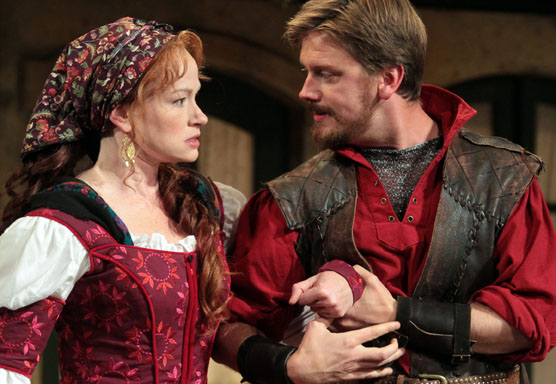
Kate (Gretchen Hall) wonders whether Petruchio’s (Fred Aresenualt) marriage intentions are true in Shakespeare Santa Cruz’s 2013 production of THE TAMING OF THE SHREW. Photos courtesy of Shakespeare Santa Cruz.
Shrew as a Problem Play, (or really just a problem)
The genre designation of Shrew is now, notoriously, unstable. It is structurally a comedy, but we no longer find the spectacle of a high-spirited woman being humiliated and starved into subjugation as funny. It is hard to produce it in a satisfactory way.
Contemporary productions attempt to get around this problem in a number of ways. The least satisfactory, but extremely common, solution is to treat the play as a combination of fairytale and farce, with no more real world implications than Roadrunner vs. Coyote.
A more sophisticated one is to undercut the message ironically, often changing the relationship of the principle couple from adversaries to secret co-conspirators. That can be very interesting, although it is accomplished by undercutting the text with contradictory behavior and line readings for a great deal of the show. I reviewed a production earlier this summer that took the latter approach successfully.
More than a few modern productions simply throw in the towel and abandon any pretense to comedy. They explore the dark underbelly of the play and let the resolution be the tragic destruction of its heroine.
The Santa Cruz Solution
Morgan’s production restores the comedic resolution in quite a novel, but quite complex, way. It is set up from the very first moments of the play, or before actually, when the cast wanders freely about the audience and onto the stage improvising around material excerpted from Shakespeare’s “induction” scene. Rarely seen in the modern theater, the “induction,” or introduction, is a sub-plot involving a town drunk named Christopher Sly. In the Folio text, he is fooled by an elaborate charade into believing he is a great lord, for whom the main play is being presented, and then – once it is underway – mysteriously disappears never to return.
The Santa Cruz production borrowed only a few lines and a bit of this subplot, but retained the detail that Sly sinks into a dreamlike stupor as the main action is beginning, in this case, downstage center on the suddenly abandoned stage.* This was related to, if not caused by, the surreal arrival of a harlequin-esque servant, Biondello (played by Andrew P. Quick), apparently kayaking – sans kayak – through the air. Sly watched a short bit of the ensuing action in which Biondello’s master, a wealthy, young Lucentio (amiably personated by Elvin McRae) arrived in town to study and have some fun. Upon realizing that the newcomers didn’t see or react to him, Sly turned to the front rows through which he was stumbling away and asked pointedly, “Am I dreaming?”
Confirmation that he was dreaming came quickly, when the same actor (the brilliant Fred Arsenault) arrived back onstage as the play’s protagonist, Petruchio. As is implied by the now common doubling of Theseus/Oberon as dream doppelgangers in Midsummer, this Petruchio was still in Sly’s clothes, but was a more powerful, successful, and confident version of him – his dream self.
Look and Feel
For much of the ensuing action, while Petruchio first woos, then weds, and finally tames the fiery Kate, the production seemed rather conventional – even old-fashioned. A director’s note tells us that the production is set, not in Padua, but in 15th Century Galacia (now a part of Spain), but it was hard to see a sharp distinction from the prototypical setting of Renaissance Italy in anything more than a bit of local color in B. Modern’s costumes. It looked and sounded like the broad comedy the play was once held to be.
The antagonist/female lead, Kate, played by Gretchen Hall, was a great deal meaner and more unsympathetic than most – the logic of which eventually became clear, as will be explored below. V Craig Heidenreich, playing Baptista, father to both Kate and a much-sought-after, mild-mannered daughter named Bianca (played by Victoria Nassif), not only looked a great deal like John Lithgow, but openly imitated his famous dead-pan, falling delivery. Petruchio’s servant, Grumio, (Conan McCarthy) was kilted and hard-drinking. Gremio, one of Bianca’s suitors, was played very broadly by local staple Kit Wilder, earning most of his laughs through funny sounds added to the ends of his lines. William Elsman played Hortensio as a more plausible third suitor for Bianca than is typical, but none of these characterizations were particularly nuanced or dimensional. Generally speaking, then, it seemed it was to be a thoroughly conventional, if lightweight, production.
Always Watch Out for the Bits that Don’t Fit
Only a couple of features truly stood out from the overall tone. First, the Puck-like Biondello was unusually prominent, and stood outside the world of the play. His actions were undertaken with literal winks and nods to the audience, and frequent deliveries of messages seemed less like missives conveyed, as assigned in the plot, than as mystical, perhaps magical, interventions to move Petruchio’s fortunes forward.
More importantly, Petruchio was a more mythic than comedic hero. He was thoroughly mercenary in pursuit of his marriage, but what was most striking was how easily successful he was at everything. A telling detail, for example, was that during a short bit of his first scene when someone else had the floor, he knocked at the window of a nearby house which opened and he was handed a drink without even having to request it. His status was made explicit when he arrived at his wedding dressed as a folk version of Piccasso’s Bull-man awaiting the maiden sacrifice. Both Petruchio’s soliloquies were beautifully rendered as confessions that he did not know if what he was doing was the right thing, but fate seemed to be pulling him forward. He seemed no less amazed than anyone else at his wife’s complete transformation in the final scene of the play where he has bet on her obedience, against Lucentio, who won Bianca, and his friend Hortensio, who lost Bianca, but married a rich widow as a consolation prize. Her heartfelt delivery of Kate’s famous monologue admonishing women to be subservient to their husbands (their lords, kings, and governors – as she says) was every man’s dream, especially considering that she had been his – apparently literal – nightmare for most of the play.
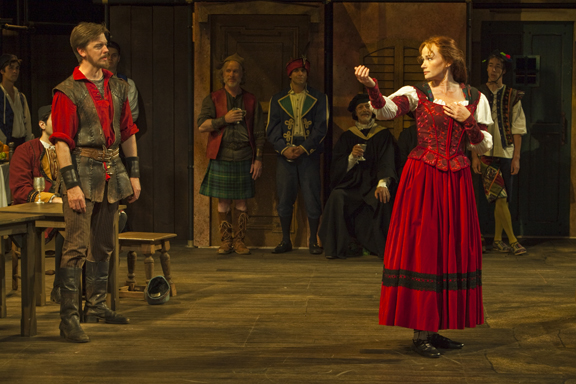
Petruchio (Fred Arsenault) is stunned by Kate’s final speech (Gretchen Hall) in Shakespeare Santa Cruz’s 2013 production of THE TAMING OF THE SHREW.
A Dream with No Bottom
Well, maybe not every man’s – but it was specifically Christopher Sly’s dream. In an ending that appears to have been suggested by a play called The Taming of A (as opposed to THE) Shrew – a play with a complicated, ambiguous relationship to Shakespeare’s play – when the stage cleared for what we thought might be the final time, instead we watched Petruchio transform back into a drunken Sly. (In A Shrew, the precise action is that Sly awakes, in a manner very reminiscent of Bottom in Midsummer, to the realization that he has been dreaming, and that his dream was a revelation. He heads home determined to tame his wife.)
In Santa Cruz’ simpler, cleaner rendering, suddenly it was clear that the play had, literally, been a male fantasy – presided over by a trickster Biondello, – and that Sly must now interpret it.
Biondello, reversing the opening, air-kayaked off into the wings. Sly was left alone – drunk, dazed and confused when (in an entirely invented scene, although pieced together out of dialogue from the induction materials in both THE and A Shrew) his wife, played by the same actress who had played Kate, arrived to fetch him home. The pitiful reality that she must pay his bill, and half-carry him home, seemed humiliating. Sly would not be moved, however, and instead (repeating a scene from the play between Petruchio and Kate) demanded to be kissed. As Kate did, his wife demurely rejected a public display of affection. As Petruchio did, Sly boldly asked, “What? Art thou ashamed of me?”
We know that the answer should be yes, but something was transformed in Sly because of his dream, and his wife saw in him a spark (of self-respect? of desire? of understanding?) that had not been there for a long time. She kissed him, her anger dissipating, and gently escorted him from the stage.
It was a genuinely affecting ending, reversing the power structure of the main play, but repeating its thematic exploration of how couples find, or create, compassionate marriages. Afterwards, I overheard a comment to the effect “that was not Shakespeare’s Shrew.” Knowing where his writing would soon go in his Green World comedies, I say, maybe not, but it sure was Shakespearean.
*Because the program notes do not discuss the textual decisions, it is impossible to tell whose ideas are at work, but the production’s textual consultant and dramaturg is the brilliant Shakespearean scholar, Michael Warren. It is a good guess that his insight might lie behind this highly original arrangement of the text. (It may have been a good guess, but turned out to be wrong. See note below.)
UPDATE: Director Edward Morgan has responded to this review to clarify that the final scene, although in the location and serving the purpose of the induction materials from A SHREW, was entirely drawn from the text of Shakespeare’s THE SHREW. He also clarified that the concept for this final scene was his, not Warren’s. I appreciate his taking the time to read and respond, and am hereby clarifying my own review. I have also made minor changes to the earlier text.
Review: A MIDSUMMER NIGHT’S DREAM at the Lake Tahoe Shakespeare Festival
August 5, 2013 § Leave a Comment
What A Concept!
Because from the second I heard of it, I loved Charles Fee’s concept for a “1960s” production of A Midsummer Night’s Dream at the Lake Tahoe Shakespeare Festival, I was in high hopes that I would love the production. As it happens, I did love parts of it a LOT, just not for reasons that had much to do with the concept.
I was excited about the way a 60s setting could emphasizing the generation gap at work between the young lovers and the older blocking figures of the Athenian court, and intrigued by the promise that the fairies in the woods would have an Indian flavor (appropriate to the text of the play), in keeping with the celebrity consciousness-raising pilgrimages to India of the time. It seemed to me the whole “Age of Aquarius” vibe might be perfect for this play which is, you know, about freedom and love, man. In many ways, the concept has the potential to be genuinely enlightening about the play. Unfortunately, little of that potential was ultimately realized, because the exploration of the 60s zeitgeist was so superficial.
Some moments did delivered on the concept: The rustics become Bohemians that arrive in a Volkswagen covered with flower power graffiti, and eventually performed their interlude with a drum that literally identified them as “Sergeant Pepper’s Lonely Hearts Club Band.”
Help!
The primary means of setting the 1960s tone was the addition of a great deal of Beatles music, which was simple played over the loudspeakers as a musical score. (The director’s note indicates his interest in the “British invasion” but I heard nothing from any other band.) This might have been a very clever idea had it been executed better. Unfortunately, however, the music often seemed imposed because of a correspondence to a word or two of the lyrics to the traditional text, rather than an overall situational correspondence. At the moment when Bottom is transformed into an ass, and the traditional text has his fellow workers running about in panic, in this production their dialogue was cut in favor of playing the Beatles song, “Help!” That was funny for exactly one word, but the song kept playing and the incongruity of hearing, “Help, I need somebody. Help, not just anybody…” grated. Such gaffes happened over and over in the course of the evening, as if the director believed no one in the audience had ever heard the music of the Beatles before and would have no idea that the songs are actually about something quite different than the use to which they were being put.
The traditional text was heavily cut in order to make room for the musical additions. It is not uncommon for theatrical productions to trim Shakespeare’s texts, of course, but in this case the extensive musical substitutions ate up valuable time, while providing less information. Some scenes were even added to the play (in mime), such as Hermia’s sneaking out of her home at dawn, simply so that a famous tune could be played. That hurt when you started missing some of the great speeches of the play just to hear a recording.
One Out of Three Ain’t Bad
Midsummer Night’s Dream, famously, has three plots. Fee’s production found almost nothing of interest in the first of these, the story of the four young lovers. He conceived them not as the freedom-seeking, idealistic youth of the 60s, (which would have been the perfect application of his concept to the play) but as shallow, trendy wanna-bes who don’t quite get it. They were, weirdly, viewed from the older generation’s perspective.
Gracyn Mix’s reading of Helena’s gorgeous soliloquy, “Love looks not with the eyes, but with the mind,” was performed in such an airheaded manner that it was impossible to take the meaning seriously, which is too bad since it is the play’s thematic core. Brad Standley’s Lysander was smugly self-involved, and it was hard to see his appeal, except in comparison to Christian Durso’s deliberately repellant Demetrius. Lori McNally as Hermia brought the most dimension to her character of the four, but even then it was the first time I have ever found myself in sympathy with her repressive father Egeus’ opinion that teenagers should not be allowed to make decisions about love for themselves, because they make them so badly.
It is unfair to blame the obviously well-trained and earnest actors since their every movement, reaction, and line reading seem heavily imposed from a directorial perspective. Although occasionally clever, the actions so lacked spontaneity that the actors ultimately devolved into puppets that we cared nothing about.
Theseus and Hippolyta were little better. The tension between them in the play’s opening appeared to set the stage for a dark reading of the play, but that tone was immediately forgotten upon Hippolyta’s first exit, and never revisited (or explained).
Oberon and Titania, doubled by the same actors playing Theseus and Hippolyta (Mic Matarrese and Carie Kawa), were more engaging, but deprived of their trains – by budgetary limitations instead of aesthetic considerations I fear – their quarrel seemed specifically personal to them and vaguely irrelevant to us. Even in the best of productions, it is hard to make clear to an audience the substance of their quarrel over a changeling boy, but in this production the perverse decision to have Puck mime a discus-like ejecting of the invisible child at his first mention compounded the problem. I can’t imagine that the director intended this as an instruction to ignore this messy plot complication since it is the central conflict, but no other interpretation seems immediately available.
 Photo by Joy Strotz
Photo by Joy Strotz
And Now, the Star of Our Show…
Speaking of Puck, the oddity at the heart of this production is that it conceived of him as the central character. The company’s perennial comedian, Jeffrey C. Hawkins, played the role with genuine star power. He is a gifted physical comedian, and a pretty good mimic, with the manic energy reminiscent of Robin Williams. He kept the show moving, and provided a great deal of comic delight in his own way, even if his Morkesque-style was more 70s than 60s. Nonetheless, the play was dangerously unbalanced by building the entire production around this peripheral character. This destabilizing began with Puck’s very first scene, which eliminated the fairy with whom he has a dialogue in the text, and turned it into a standup monologue. It continued all the way to the end of the show when the traditional blessing masque was entirely eliminated in favor of foregrounding Puck’s final speech as a stand-alone bookend to his opening monologue. Although he serves to complicate it, Puck has no real investment in the action of the play, and making it all about him means that nothing is at stake.
It Sure Is Pretty Here
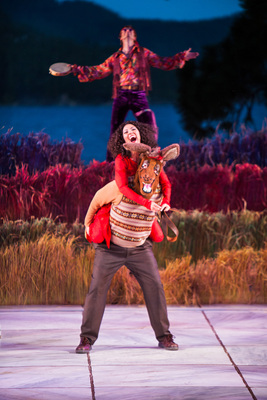 Photo by Joy Strotz
Photo by Joy Strotz
For all its shortcomings however, this production had some obvious strengths that ultimately carried the evening. The first of these was the beautiful, as well as very functional, scenic design by Gage Williams. As with most productions of A Midsummer Night’s Dream, we entered to see a classically Greek colonnade in front of a marble back wall. At the end of the first act when the action moved to the woods, the entire back wall opened up to reveal the vista across Lake Tahoe with only a psychedelically multicolored reed groundrow at the back edge of the stage. It was a brilliant marriage of minimal scenery and natural setting. The costumes by Star Moxley were appropriate to the period, as well as witty selections from the 1960s wardrobe. The Eastern robes of the fairies were particularly inspired, with their gorgeous draping and elegant flow. Rick Martin’s lighting design kept our eyes where they needed to be, without overpowering the natural background that made the evening spectacular.
Bottom and Our Gang
It would have been a difficult, even failed, evening if the only highpoint had been the spectacle. This was a production that soared upon the entrance of the rude mechanicals, however, in that beat-up VW bug. They were endlessly inventive, and downright hilarious in their roles as would-be actors. Half-dressed and obviously tripping, they later became the fairies surrounding Bottom and Titania, which was not just guffaw-inducing, but interpretively enlightening.
Their byplay in the woods provided genuine levity, but their performance of the (admittedly foolproof) play-within-a-play in the final act was as funny as I have ever seen it. Shad Willingham brought hearty charm to Bottom’s extroversion, and the same engaging physicality previously seen in his transformation into an ass. Dustin Tucker was hysterical as Peter Quince, reveling in his role as director. Jo Atack as Snout the tinker and Sonny Valicenti as Starveling the tailor kept up although their parts are small.
As happens in almost every production of A Midsummer Night’s Dream, teenage Flute reluctantly taking on the female role of Thisbe in the play-within-the-play stole the show. Ryan David O’Bryne was a skipping, tripping revelation as he started getting “naturally high” on being in the limelight.
The biggest surprise was Wesley Gaines McNair’s touching, highly original interpretation of Snug the joiner. Instead of playing the character as dense, McNair’s found in him a debilitating shyness. His portrait of the Lion – who frightened only himself – in front of the Duke brought sighs of “Ahhhhhhhh” from the audience, and explained (for once) the Duke’s change of heart from contempt for the superficial playing to sympathy for the earnest efforts of the sincere, if incompetent, amateur performers.
Although almost always funny, the fifth act of this production was so relentlessly delightful that the entire evening was redeemed. I remained a little perplexed about the intent of the 1960s concept, however, even through the majority of the final scene. The intended payoff only became clear at the very last moment of the evening when the Duke and Duchess, and the four young lovers, had departed the stage leaving behind only the curtain before which the rustics had played. Then, in a gorgeous backlit image, we suddenly got the silhouette of the Fab Four and over the loudspeakers we heard, “Love, Love, Love.” If only the production that had preceded it had actually had more to say about love it might have been the cleverest idea ever.


